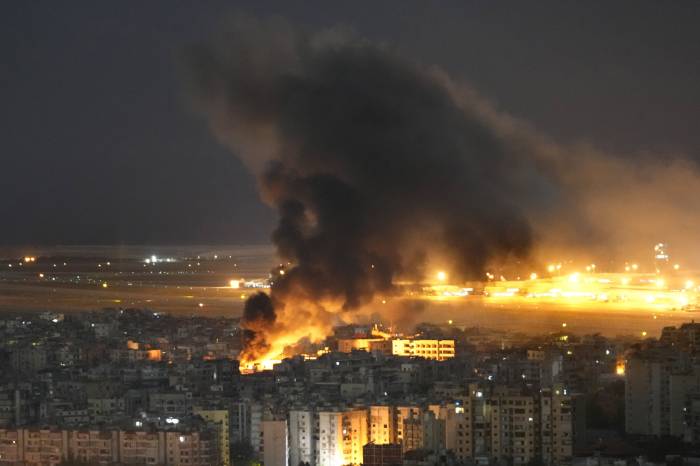From October 21 to 25, 2024, the situation in the Middle East remained highly tense, involving multiple conflict fronts. Hostilities between Israel and Hamas in the Gaza Strip intensified, while tensions with Hezbollah on the northern border escalated. Lebanon faced severe consequences from ongoing military operations, and rising tensions between Israel and Iran continue to pose serious risks to regional stability, News.Az reports.
Israel-Hamas conflict
The ongoing conflict between Israel and Hamas has intensified, with both sides engaging in continuous and escalating hostilities. On October 22, 2024, the Israel Defense Forces (IDF) launched a series of airstrikes targeting Hamas and Palestinian Islamic Jihad (PIJ) positions in the Gaza Strip. These strikes were aimed at crippling the operational capabilities of these groups, particularly focusing on infrastructure used for launching rockets and operating tunnels.
In a strategic move, elements of the IDF’s 143rd Division executed an operation in Beit Lahia, a key location in the Gaza Strip. During this mission, they successfully destroyed several tunnel entrances and rocket launch sites, reducing the ability of Hamas and PIJ to carry out further attacks. However, these actions did not go unanswered; the al Aqsa Martyrs’ Brigades, a militant group aligned with Hamas, responded by launching rockets targeting Israeli forces around the Netzarim Corridor. The situation in Gaza remains dire, with civilians bearing the brunt of the ongoing violence.
Israel-Hezbollah tensions
The conflict has also heightened tensions between Israel and Hezbollah. Over the past few days, Hezbollah has conducted multiple attacks on Israeli forces, towns, and air assets. Reports indicate that at least 39 attacks were carried out within a 24-hour period, highlighting the scale and intensity of the confrontations. The IDF has responded by intensifying its air campaign against Hezbollah, launching strikes across Lebanon aimed at degrading Hezbollah’s military infrastructure.
Notable targets included munition depots and key facilities in Dahiyeh, Beirut, known to be a Hezbollah stronghold. The IDF also targeted a Hezbollah naval base near Rafik Hariri International Airport in Dahiyeh. These strikes indicate a broader strategy by Israel to weaken Hezbollah’s logistical and military capabilities, thereby reducing the group’s ability to threaten Israeli security.
Lebanon: A nation in crisis
The ongoing conflict has severely impacted Lebanon, which finds itself at the center of a regional crisis. The Lebanese Health Ministry reported that on October 21, the country experienced its highest single-day death toll from Israeli strikes since the end of September, with 63 fatalities. As of October 22, the cumulative death toll had surged to 2,530, reflecting the devastating human cost of the conflict.
International efforts to mediate the situation are ongoing. U.S. special envoy Amos Hochstein visited Lebanon on October 21 in a bid to broker a ceasefire and explore a permanent solution to the Israel-Lebanon conflict. Hochstein’s visit signals a significant diplomatic push to de-escalate the situation, but whether it will yield tangible results remains uncertain, as both Israel and Hezbollah continue to prepare for prolonged confrontation.
Israel-Iran relations: A tense standoff
While the immediate focus has been on the direct conflicts with Hamas and Hezbollah, Israel’s ongoing operations have broader implications, particularly concerning its relations with Iran. Israeli intelligence officials have stated that recent military actions in Lebanon have disrupted Iran’s efforts to fund Hezbollah, which is seen as a critical arm of Iran’s regional influence. By targeting Hezbollah’s financial networks, including airstrikes on branches of al-Qard al-Hasan—a financial institution linked to the group—Israel is attempting to cut off a vital support channel.
The assassination of a high-ranking Hezbollah financier earlier in October has added another layer of complexity to the situation. This targeted killing has escalated tensions, with Iran-backed groups signaling their intent to respond. The financial and military connections between Iran and Hezbollah make this situation a significant flashpoint, with the potential for further regional destabilization.
The situation across the Middle East remains volatile, with each front of the conflict intricately linked to broader geopolitical dynamics. The ongoing Israel-Hamas conflict, tensions with Hezbollah, and the underlying standoff with Iran collectively paint a picture of a region on the edge. Diplomatic efforts, such as those led by the U.S., are crucial in attempting to bring about de-escalation, but the entrenched positions of the involved parties make a swift resolution challenging. As military operations continue, the focus remains on how regional actors will navigate this complex and highly charged environment.
